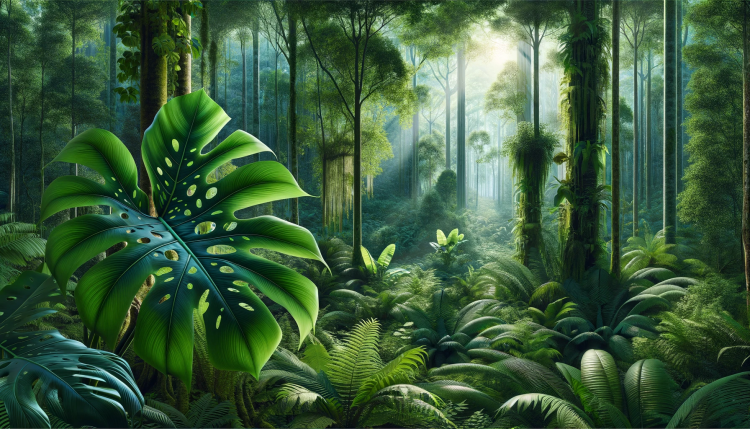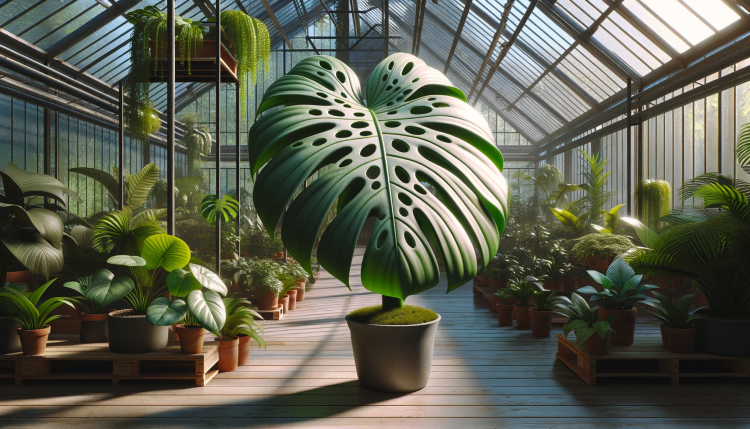
Quick Identification Guide for Monstera (Genus Monstera):
Botanical Name: Monstera spp.
Family: Araceae (the arum family).
Origin and Natural Habitat:
- Native to tropical regions of the Americas, from southern Mexico to Panama.
- Commonly found in rainforests, where they grow in the understory with moderate light and high humidity.
Physical Characteristics:
- Leaves: Monstera is known for its large, glossy, heart-shaped leaves. Mature leaves are often perforated with holes or slits, leading to the nickname “Swiss Cheese Plant.” The size and shape of the holes can vary significantly among species and individual plants.
- Stems: Thick stems that can climb and adhere to surfaces with aerial roots.
- Flowers and Fruit: Rarely flowers indoors, but in its natural habitat, it produces arum-like flowers followed by edible fruit in some species, like Monstera deliciosa.
Common Species:
- Monstera deliciosa: The most widely recognized species, known for its large, perforated leaves.
- Monstera adansonii: Smaller leaves with more numerous and pronounced holes.
Plants Commonly Confused With:
- Philodendron: Similar climbing habit and leaf shape, but philodendrons generally don’t have the distinctive holes or slits in their leaves.
- Split-Leaf Philodendron (Philodendron bipinnatifidum): Often confused with Monstera, but the leaves are deeply cut, not perforated.
- Pothos (Epipremnum): Sometimes mistaken for young Monstera plants due to the shape of the leaves and climbing nature, but Pothos leaves are smaller and do not develop holes.
Growth Habit and Care:
- Monstera plants are climbers and can grow quite large, particularly Monstera deliciosa.
- They prefer bright, indirect light and high humidity, similar to their native tropical rainforest environment.
- Over-watering can be an issue; it’s important to let the soil dry out slightly between waterings.
Uses and Cultivation:
- Popular as indoor houseplants due to their striking foliage and relatively easy care.
- In their native habitat, some species’ fruit is edible and known as the “fruit salad” plant.
Cultivation Challenges:
- Requires space to grow; can become too large for some indoor areas.
- Prone to pests like spider mites and mealybugs in dry indoor environments.
Cultural Significance:
- Monstera is popular in interior design and often used in tropical-themed décor.
- Its unique leaf shape has made it a popular motif in art, textiles, and design.


Quick Facts About Monstera
Botanical Name: The genus Monstera belongs to the family Araceae.
Common Names: Known as the “Swiss Cheese Plant” due to the distinctive holes in its leaves.
Origin: Native to tropical forests of Central and South America.
Habitat: Thrives in the understory of rainforests, where it receives dappled light and high humidity.
Leaf Characteristics:
- Famous for its large, glossy, heart-shaped leaves.
- Mature leaves develop characteristic holes (fenestrations) and slits, which help the plant withstand heavy rainfall and wind in its natural habitat.
Species Diversity:
- Several species are popular in cultivation, but Monstera deliciosa is the most well-known.
- Monstera adansonii, with smaller, more perforated leaves, is also a popular houseplant.
Growth Habit:
- In the wild, Monstera plants are climbers, using aerial roots to attach to trees.
- They can grow very large, with leaves spanning over a foot in diameter in Monstera deliciosa.
Flowers and Fruit:
- Rarely blooms or produces fruit indoors.
- In its natural environment, it produces a spadix (a type of flower spike) surrounded by a spathe, similar to other aroid plants.
- The fruit of Monstera deliciosa is edible and tastes similar to a combination of pineapple and banana.
Indoor Cultivation:
- Popular as an indoor plant due to its striking foliage and adaptability to indoor conditions.
- Prefers bright, indirect light and high humidity. Direct sunlight can scorch its leaves.
- Requires well-draining soil and should be watered when the top inch of soil feels dry.
Air Purification: Like many houseplants, Monstera is believed to help purify indoor air, although the extent of this benefit is subject to debate among scientists.
Propagation:
- Easily propagated from stem cuttings, particularly those with aerial roots.
- Can be rooted in water or directly in soil.
Pests and Diseases:
- Common pests include mealybugs, spider mites, and scale insects.
- Over-watering can lead to root rot.
Toxicity:
- All parts of the plant are toxic if ingested due to the presence of calcium oxalate crystals.
- Can cause mouth irritation and gastrointestinal discomfort if eaten by pets or humans.


Cultural Popularity:
- Has gained significant popularity as an ornamental plant in homes and offices.
- Often featured in interior design and social media for its aesthetic appeal.
Historical Use:
- In some cultures, the aerial roots of Monstera were used as ropes or in basket weaving.
- The large leaves have traditionally been used in some tropical regions for wrapping or serving food.
Climbing Support in Cultivation:
- When grown indoors, Monstera plants may require support to mimic their natural climbing habit. This can be provided through stakes, trellises, or a moss pole.
Pruning and Maintenance:
- Pruning can help control its size and shape, particularly in indoor settings.
- Regular cleaning of the leaves is recommended to maintain their glossy appearance and promote healthy growth.
Varieties and Cultivars:
- Numerous cultivars have been developed, including variegated varieties like Monstera deliciosa ‘Variegata’, which are highly sought after for their unique leaf patterns.
Commercial Use:
- Apart from being a popular houseplant, Monstera leaves are also used in floral arrangements and as a decorative element in various events and settings due to their exotic and tropical appearance.
Symbolism:
- Often symbolizes longevity and respect in different cultures.
- Its unique appearance has made it a symbol of exoticism and a favorite in art and fashion.





